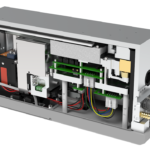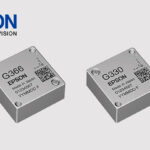ASIA ELECTRONICS INDUSTRYYOUR WINDOW TO SMART MANUFACTURING
Epson Expands Its Lineup of IMU Platform
Seiko Epson Corporation has expanded its inertial measurement unit1 (IMU) lineup with the development of the M-G370PDG (M-G370G), an IMU equipped with a high-performance, six degrees of freedom sensor. The M-G370G will enter volume production in July 2023.
First launched in 2011, Epson’s IMUs have been used in an array of customer applications. Particularly, from precision agriculture (GNSS2) and industrial drones to camera and antenna platform vibration control and stabilization. Thus, earning an excellent reputation for outstanding performance and quality.
Epson has a full range of IMUs, from basic models to high-spec models. All are based on a platform that measures about one inch along the sides, the standard form factor for IMUs.

Precision Sensors
As with the standard and basic models, the high-spec M-G370G allows users to select an accelerometer output range of either ±8G or ±16G. Thurs, offering 0.05% non-linearity3 of the full-scale range of the gyroscopic sensor. These features enable the new IMU to accurately measure all types of motion, from slow to fast.
By expanding and enhancing its lineup of small, lightweight, low-power, one-inch platform products, Epson is giving customers more options. Thereby, allowing them to choose a product that has the best functions and performance for their needs and applications.
Epson plans to exhibit the M-G370G at Maintenance and Resilience Tokyo 2023 (organized by the Japan Productivity Association) from July 26-28 at Tokyo Big Sight.
Given the social and technological changes that are underway, Epson believes that the need for precision sensors that can visualize information will only expand going forward.
For that reason, Epson said it will continue to leverage its philosophy of efficient, compact, and precise innovation. This is to provide small, lightweight, low-power sensing systems that offer outstanding precision and stability to significantly contribute to our customers’ products and services.
Product Features
- One-inch platform (24 x 24 x 10 mm3)
- Downward compatible with the M-G330 and M-G366, M-G370, M-G370S, sharply reducing customer development costs and evaluation time
- User selectable accelerometer output range at ±8G or ±16G
- Gyroscopic sensor non-linearity is 0.05% for the sensor’s full scale range
- Low current consumption: 16 mA
- Product Applications
- Vibration damping for cameras, antennas, etc.
- Unmanned vehicles (industrial drones, terrestrial vehicles, sea probes, etc.)
- Vibration, angle, trajectory measurement of industrial equipment, etc.
- Navigation systems (GNSS, INS4, high-precision locators), etc.
Notes:
1 Inertial measurement unit (IMU)
An IMU is a device that is used for sensing inertial motion. It is comprised of triaxial angular rate sensors and triaxial accelerometers.
2 A global navigation satellite system (GNSS)
A satellite system that is used to pinpoint a geographic location anywhere in the world
3 Non-linearity
The maximum deviation from an approximate straight line of the output versus input of a gyroscopic sensor or accelerometer. It is typically expressed as a percentage of the full scale.
4 Inertial navigation system (INS)




